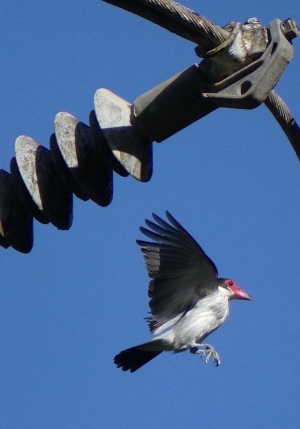- Tityra cayana
Identification
20-22cm (7¾-8½ in)
- Greyish-white above
- White underparts
- Black crown, sides of head and tail
- Red encircling the eyes
- Black-tipped red bill
- Dark iris and feet
Female:
- Dark brown wings and tail
- Brown patterning on head, back and underside
Distribution
From Trinidad and northern South America to Argentina, Paraguay, Brazil and Bolivia.
Taxonomy
Subspecies
There are 2 subspecies[1]:
- T. c. braziliensis:
- T. c. cayana:
Habitat
Canopy and borders of lowland and foothill forests and secondary woodland.
Behaviour
Diet
The diet consists mainly of fruit; many insects are also taken, especially to feed to their young.
Breeding
They nest in old tree holes (often those previously used by woodpecker). It is lined with dry leaves and small twigs. The clutch may consist of 3 buff eggs, with brown marks. They are incubated by the female for approximately three weeks; both parents feed the chicks.
References
- Clements, J. F., T. S. Schulenberg, M. J. Iliff, D. Roberson, T. A. Fredericks, B. L. Sullivan, and C. L. Wood. 2016. The eBird/Clements checklist of birds of the world: v2016, with updates to August 2016. Downloaded from http://www.birds.cornell.edu/clementschecklist/download/
- Handbook of the Birds of the World Alive (retrieved February 2017)
- Wikipedia
Recommended Citation
- BirdForum Opus contributors. (2025) Black-tailed Tityra. In: BirdForum, the forum for wild birds and birding. Retrieved 15 January 2025 from https://www.birdforum.net/opus/Black-tailed_Tityra
External Links
Search the Gallery using the scientific name:
Search the Gallery Using the common name:
GSearch checked for 2020 platform.






